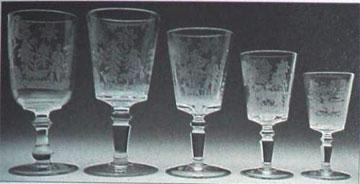 By Pamela K. Zachary The Deer & dog finial, the cornerstone of the pattern, showing superior glass craftsmanship. |
 |
Sometime around 1881, the Gillinder & Sons factory in Philadelphia, Pennsylvania introduced Deer and Dog AKA Frosted Dog or Deer, Dog and Hunter. The mold pattern is credited to John Putnam, who was the mold shop foreman. Large acid etched dogs are the finials for the covered pieces. |
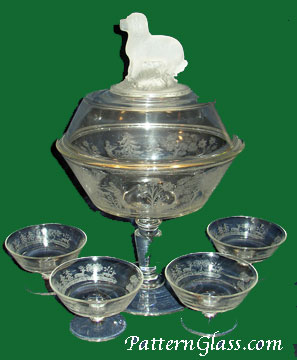 |
These are example of extraordinary
glass work with the dog standing at full attention. Sometimes referred
to as a St. Bernard, retriever
or Newfoundland the finials have superior detail. In the plates & relish
dishes, his name is Barry. One might suppose that with the attention to the Lewis & Clark Expedition, the artist may have the Newfoundland in mind for the finial model. Newfoundlands were a highly publicized members of that the Corp of Discovery which of course paved the way for Western expansion. Curiosity about the “West” was at full throttle during this time and the Gillinder factory provided homes with glassware full of images of the “Frontier” with patterns like Deer & Dog and Westward Ho along with other beautiful pattern glass. This is not to be confused with the Fostoria St. Bernard which features a reclining St. Bernard as the finial or the Duncan Shell and Tassel which features reclining retrievers as the finials on the covered pieces. Deer and Dog may be found plain and etched as shown in the photographs below. |
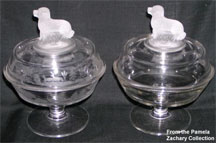 |
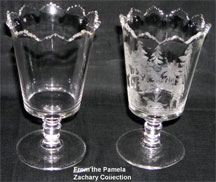 |
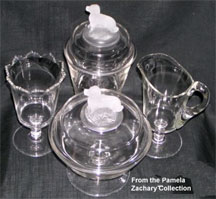 |
Examples of the covered butter dishes in etched
and plain. The covered butter dish and sugar bowl both have the
dog finial. The etch on the butter dish shows running deer with dogs
in pursuit without the hunter. Often the butter dish is misidentified
as a low compote. |
Two spooners - a plain one on the left and etched on the right. |
A rare Table Set; cov'd butter, cov'd sugar,
spooner &
creamer were made plain as shown above and etched as shown on the butter
dish above. |
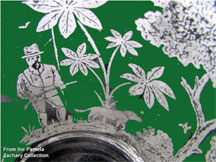 |
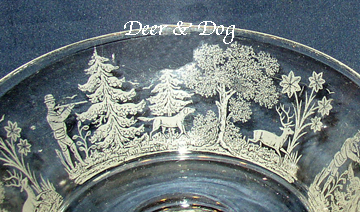 |
 |
| The etched pieces use variations of Gillinder design No.14. The motif consists of both grazing and running deer, three variations of hunters all paired with a rather incongruous mixture of plant species. The use of the stencil varies from piece to piece from the deer and dogs with plants on the covered butter dishes, variations of the stencil with two different hunters used on the goblets and covered marmalade then a full stencil rendition used on the covered compotes. Interestingly, the constant pattern repeat on all the etched pieces are the plants. The varying images of the deer, dog and hunter are shown in the photographs. Deer and Dog uses variations of the etch on different pieces. The goblets and spooner have the deer on alert with the dog close to his master dressed in "gentleman" hunting wear. | ||
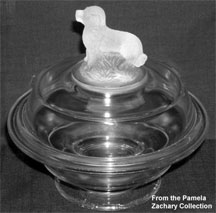 |
The consistent tie of all the covered pieces is of course the dog finial. The most difficult pieces to find are the marmalade with the dog finial cover (see at right) and the low covered bowls either plain (at left) or etched which are considered rare. Previously, the covered bowls were only reported in the oval shape however two examples of round covered bowls have recently been discovered. A 6-inch high standard covered compote is also a new discovery. |
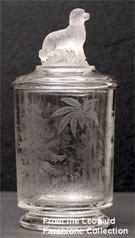 |
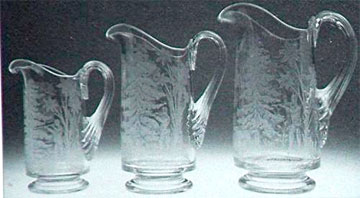 |
The three known sizes of pitchers, all of which have a reeded handle. On the left, a1 quart pitcher, in the middle a milk pitcher and the on the right is the 2 quart water pitcher. The milk pitcher is particularly rare. |
What a grand vision, three high standard
round covered Deer & Dog compotes shown here in a previously undocumented 6-inch, 7-inch
and an 8-1/4-inch. The etch on these pieces uses a complete scene of
the hunter with his trusty canine in pursuit of the deer. This plays
as an action scene as your eyes follow the etch around the base and lid. |
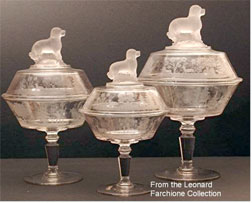 |
